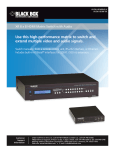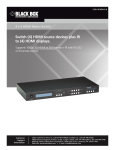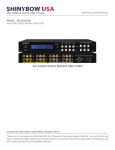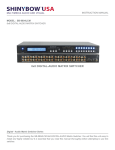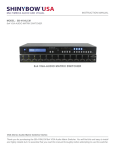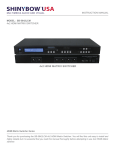Download USER MANUAL - memo
Transcript
Kramer Electronics, Ltd. USER MANUAL Model: VP-724DS, Seamless Switcher / Scaler Contents Contents 1 Introduction 1 2 Getting Started 1 3 Overview 2 4 Your VP-724DS Seamless Switcher / Scaler 3 5 5.1 Connecting the VP-724DS Seamless Switcher / Scaler Connecting a PC 7 8 6 6.1 6.2 Understanding the VP-724DS Seamless Switcher / Scaler Understanding the OUT Button Functionality Understanding the PIP Button Feature 10 10 12 6.2.1 6.2.2 6.2.3 6.2.4 6.2.5 Activating the PIP Feature PIP Characteristics Toggling between the PIP and the Screen Source (SWAP) Resizing the PIP Moving the Position of the PIP 12 13 13 14 14 6.3 Locking and Unlocking the Front Panel 14 7 7.1 Operating the VP-724DS Seamless Switcher / Scaler Switching and Scaling 15 15 7.1.1 7.1.2 Switching an Input Choosing the Output Resolution 15 16 7.2 7.3 Controlling the Seamless Switcher / Scaler Operating via the OSD MENU Screen 16 16 7.3.1 7.3.2 7.3.3 7.3.4 7.3.5 Controlling the Brightness and Contrast Controlling the Gamma and Color Selecting the Source Controlling the Scale Geometry Adjusting the Zoom Ratio and Position 17 18 19 19 21 7.3.5.1 7.3.5.2 Adjusting the Zoom Ratio Adjusting the Zoom Position 22 22 7.3.6 Configuring via the Utility Screens 24 7.3.6.1 7.3.6.2 7.3.6.3 7.3.6.4 7.3.6.5 7.3.6.6 7.3.6.7 7.3.6.8 Choosing the Graphic Utility Settings Choosing the Video Utility Settings Choosing the Audio Utility Settings Choosing the PIP Utility Settings Choosing the Seamless Switch Utility Settings Choosing the OSD Utility Settings Choosing the Output Utility Settings Choosing Factory Reset 24 25 26 27 29 29 31 32 7.3.7 Verifying Configuration Details via the Information Screen 33 i Contents 7.3.8 Operating via the Infra-red Remote Control Transmitter 33 7.4 Upgrading Firmware 36 8 Technical Specifications 36 9 VP-724DS Communication Protocol 37 Figures Figure 1: VP-724DS Seamless Switcher / Scaler Figure 2: Connecting the PC Figure 3: Connecting the VP-724DS Rear Panel Figure 4: VP-724DS OUT LED Sequence Figure 5: OSD PIP Status Figure 6: OSD SWAP Status Figure 7: Locking / Unlocking the Front Panel Figure 8: OSD Input Status Figure 9: OSD Output Status Figure 10: MENU Screen Figure 11: Menu Screen Icons Figure 12: Brightness and Contrast Screen Figure 13: Gamma and Color Screen Figure 14: Gamma, Color Temperature/Manager User 1/2 Screen Figure 15: Source Selection Screen Figure 16: Geometry (Scale and Zoom) Screen Figure 17: Geometry (Scale: Aspect Ratio and Nonlinear) Screen Figure 18: Geometry (Scale: Aspect Ratio) Screen Figure 19: Geometry (Zoom) Screen Figure 20: OSD Enlarge Status Figure 21: Zoom Ratio Adjustment Example Figure 22: Zoom Position Adjustment Example Figure 23: Geometry (Zoom Ratio) Screen Figure 24: Preset Position Control Keys Figure 25: Navigation Control Keys Figure 26: Geometry (Zoom Position Adjustment) Screen Figure 27: Utility Screen Figure 28: Graphic Setting Utility Screen Figure 29: Graphic Setting Color Format Utility Screen Figure 30: Video Setting Utility Screen Figure 31: Video Setting Standard Utility Screen Figure 32: Audio Setting Utility Screen Figure 33: Audio Setting Stereo Utility Screen Figure 34: PIP Utility Screen Figure 35: PIP Activation Utility Screen Figure 36: PIP Source Utility Screen Figure 37: PIP Size Utility Screen ii 4 8 9 11 13 13 14 15 16 17 17 17 18 18 19 19 20 20 21 21 22 22 22 23 23 23 24 24 25 25 25 26 26 27 27 27 28 KRAMER: SIMPLE CREATIVE TECHNOLOGY Contents Figure 38: Seamless Switch Utility Screen Figure 39: OSD Setting Utility Screen Figure 40: OSD Size Utility Screen Figure 41: OSD Source Prompt Activation Utility Screen Figure 42: OSD Blank Color Utility Screen Figure 43: Output Setting Utility Screen Figure 44: Output Setting Resolution Utility Screen Figure 45: Output Setting Refresh Rate Utility Screen Figure 46: Output Setting User Mode Setting Utility Screen Figure 47: Factory Reset Utility Screen Figure 48: Information Screen Figure 49: Infra-red Remote Control Transmitter 29 29 30 30 30 31 31 31 32 32 33 34 Tables Table 1: Front Panel VP-724DS Seamless Switcher / Scaler Features Table 2: Rear Panel VP-724DS Seamless Switcher / Scaler Features Table 3: Selecting the Output Resolution Table 4: User Mode Setting Definitions Table 5: Infra-red Remote Control Transmitter Functions Table 6: Technical Specifications of the VP-724DS Table 7: RS-232 Protocol Table 8: RS-232 Communication Code Table 9: RS-232 Read Command 5 6 10 32 35 36 37 37 39 iii Introduction 1 Introduction Welcome to Kramer Electronics (since 1981): a world of unique, creative and affordable solutions to the infinite range of problems that confront the video, audio and presentation professional on a daily basis. In recent years, we have redesigned and upgraded most of our line, making the best even better! Our 300-plus different models now appear in 8 Groups1, which are clearly defined by function. Congratulations on purchasing your Kramer VP-724DS Seamless Switcher / Scaler, which is ideal for the following typical applications: • Presentation and conference room systems • Production studios, rental and staging The VP-724DS is an enhanced version of our popular VP-720DS and VP-723DS models, and includes an additional VGA HD15 input connector, as well as a stereo audio terminal block connector for each of the 8 inputs. The package includes the following items: • VP-724DS Seamless Switcher / Scaler • Power cord2 • Infra-red remote control transmitter • Null-modem adapter • This user manual3 and the Kramer concise product catalog/CD 2 Getting Started We recommend that you: • Unpack the equipment carefully and save the original box and packaging materials for possible future shipment • Review the contents of this user manual • Use Kramer high performance high resolution cables4 1 GROUP 1: Distribution Amplifiers; GROUP 2: Video and Audio Switchers, Matrix Switchers and Controllers; GROUP 3: Video, Audio, VGA/XGA Processors; GROUP 4: Interfaces and Sync Processors; GROUP 5: Twisted Pair Interfaces; GROUP 6: Accessories and Rack Adapters; GROUP 7: Scan Converters and Scalers; and GROUP 8: Cables and Connectors 2 We recommend that you use only the power cord that is supplied with this machine 3 Download up-to-date Kramer user manuals from the Internet at this URL: http://www.kramerelectronics.com/manuals.html 4 The complete list of Kramer cables is on our Web site at http://www.kramerelectronics.com (click “Cables and Connectors” in the Products section) 1 Overview 3 Overview The VP-724DS is a Seamless Switcher / Scaler designed for a wide variety of presentation and multimedia applications. It is a true multi-standard video to RGBHV (pixel) scaler that converts composite video, s-Video, component video, VGA/SVGA/XGA/UXGA, and DVI signals to the following 17 user-selectable pixel rates: • VGA (640x480) • SVGA (800x600) • XGA (1024x768) • SXGA (1280x1024) • UXGA (1600x1200) • 852x1024 • 1024x1024 • 1366x768 • 1365x10241 • 1280x7201 • 720x4831 • 852x4801 • 1400x10501 The VP-724DS also has 3 additional output modes used for high definition television (HDTV): 480p, 720p, and 1080i, as well as a user definable output mode2. The VP-724DS is an 8-input Seamless Presentation Switcher, that: • Digitally reprocesses the signal to correct mastering errors, and regenerates the video at a chosen line and pixel rate format, providing, for example, native-resolution video for LCD, DLP and Plasma displays • Facilitates scaling of any graphics resolution to any other resolution3 • Incorporates a unique graphics-scaling engine with image enhancement algorithms, which are built into the firmware • Includes a built-in Picture-in-Picture inserter4, letting you insert a video source into a graphics background or vice versa, allowing the user to size and position the shrunken inserted image anywhere on the screen 1 Not shown on the front panel 2 Recommended for advanced users only – non-standard settings may not be recognized by the display device 3 For example, scaling a VGA input to an UXGA output, or an SXGA input to an SVGA output 4 See section 6.2 2 KRAMER: SIMPLE CREATIVE TECHNOLOGY Your VP-724DS Seamless Switcher / Scaler • • Is specifically designed to improve video quality by reducing chroma noise Scales and zooms (to up to 400% of the original size) In addition, the VP-724DS: • Switches the 8 audio channels in audio-follow-video mode • Includes an OSD (on-screen display) for making the adjustments that can be located anywhere on the screen, and can be doubled in size. The OSD can be used to deactivate the source prompt, choose the color of the blank screen, and choose from three seamless switching image transition speeds • Includes eight multi-functional input buttons that cycle between selecting a source, freezing that source, or deactivating that source (and displaying a blank screen) • Includes a front panel lock • Incorporates full ProcAmp1 processing for video and audio correction • Offers high quality de-interlacing 3:2/2:2 pull down2 • Can provide non-linear scaling for 4:3, 16:9 transformation3 • Supports firmware upgrade via RS-232 • Includes non-volatile memory that retains the last setting, after switching the power off and then on again Control the VP-724DS: • From the front panel OSD control buttons • Remotely, from the infra-red remote control transmitter • Remotely, via RS-232 Achieving the best performance means: • Connecting only good quality connection cables, thus avoiding interference, deterioration in signal quality due to poor matching, and elevated noise levels (often associated with low quality cables) • Avoiding interference from neighboring electrical appliances and positioning your VP-724DS away from moisture, excessive sunlight and dust 4 Your VP-724DS Seamless Switcher / Scaler Figure 1, and Table 1 and Table 2, define the VP-724DS Seamless Switcher / Scaler: 1 Processing amplification enables adjustment of different video and audio signal parameters 2 Accommodates the frame-rate of a converted movie (24 frames per second) to video frequencies (25 frames per second (PAL); 30 frames per second (NTSC) 3 See Figure 18 3 Your VP-724DS Seamless Switcher / Scaler Figure 1: VP-724DS Seamless Switcher / Scaler 4 KRAMER: SIMPLE CREATIVE TECHNOLOGY Your VP-724DS Seamless Switcher / Scaler Table 1: Front Panel VP-724DS Seamless Switcher / Scaler Features 11 12 13 14 15 16 INPUT SELECTOR LEDs 6 7 8 9 10 Feature POWER Switch IR Receiver / LED AV1 AV2 YC1 OUT LEDs # 1 2 3 4 5 Function Illuminated switch supplying power to the unit Green when the unit will accept IR remote commands Illuminates1 when the composite video / audio source 1 is selected 1 Illuminates when the composite video / audio source 2 is selected 1 Illuminates when the s-Video (Y/C) / audio source 1 is selected YC2 Component VGA 1 VGA 2 DVI Illuminates1 when the s-Video (Y/C) / audio source 2 is selected 1 Illuminates when the component video / audio source is selected 1 Illuminates when the VGA / audio source 1 is selected 1 Illuminates when the VGA / audio source 2 is selected 1 Illuminates when the DVI / audio source is selected SV V X 1366x768 Illuminates when the SVGA resolution is selected Illuminates when the VGA resolution is selected3 4 Illuminates when the XGA resolution is selected 5 Illuminates when the 1366x768 resolution is selected 2 852x1024 Illuminates when the 852x1024 resolution is selected6 7 1024x1024 Illuminates when the 1024x1024 resolution is selected 1 Flashes when the image is frozen, and flashes more slowly when a blank screen is displayed 2 Illuminates with the V LED when the SXGA resolution is selected, with the X LED when the UXGA resolution is selected, with the 852x1024, 1024x1024 and 1366x768 LEDs when the 852x480 resolution is selected, with the 1024x1024 LED when 720p is selected, and with all the other LEDs when UserDefine is selected 3 Illuminates with the SV LED when the SXGA resolution is selected, with the 852x1024, 1024x1024 and 1366x768 LEDs when the 720x483 resolution is selected, with the 852x1024 LED when 480p is selected, and with all the other LEDs when UserDefine is selected 4 Illuminates with the SV LED when the UXGA resolution is selected, with the 852x1024, 1024x1024 and 1366x768 LEDs when the 1400x1050 resolution is selected, with the 1366x768 LED when 1080i is selected, and with all the other LEDs when UserDefine is selected 5 Illuminates with the 1024x1024 LED when the 1280x720 (not shown on the front panel) resolution is selected, with the V, 852x1024, and 1024x1024 LEDs when the 720x483 resolution is selected, with the SV, 852x1024, and 1024x1024 LEDs when the 852x480 resolution is selected, with the X, 852x1024, and 1024x1024 LEDs when the 1400x1050 resolution is selected, with the X LED when 1080i is selected, and with all the other LEDs when UserDefine is selected 6 Illuminates with the 1024x1024 LED when the 1365x1024 (not shown on the front panel) resolution is selected, with the V, 1024x1024, and 1366x768 LEDs when the 720x483 resolution is selected, with the SV, 1024x1024, and 1366x768 LEDs when the 852x480 resolution is selected, with the X, 1024x1024, and 1366x768 LEDs when the 1400x1050 resolution is selected, with the V LED when 480p is selected, and with all the other LEDs when UserDefine is selected 7 Illuminates with the 852x1024 LED when 1365x1024 (not shown on the front panel) resolution is selected, with the 1366x768 LED when the 1280x720 (not shown on the front panel) is selected, with the V, 852x1024, and 1366x768 LEDs when the 720x483 resolution is selected, with the SV, 852x1024, and 1366x768 LEDs when the 852x480 resolution is selected, with the X, 852x1024, and 1366x768 LEDs when the 1400x1050 resolution is selected, with the SV LED when the 720p is selected, and with all the other LEDs when UserDefine is selected 5 Your VP-724DS Seamless Switcher / Scaler 26 27 28 29 30 31 32 33 Feature OUT Button PIP LED UP Button DOWN Button + Button - Button ENTER Button MENU Button PIP Button INPUT SELECTOR Buttons # 17 18 19 20 21 22 23 24 25 Function 1 Selects the output resolution and illuminates the appropriate LED Illuminates when the picture-in-picture function is selected Moves up one step (in the same level) in the OSD screen Moves down one step (in the same level) in the OSD screen Increases the range by one step in the OSD screen Decreases the range by one step in the OSD screen Moves to the next level in the OSD screen 2 3 Displays the OSD Menu screen and locks/unlocks the front panel Selects the picture-in-picture function and illuminates the PIP LED4 DVI VGA 2 Press5 to select the DVI / audio source and illuminate the DVI LED 5 Press to select the VGA / audio source 2 and illuminate the VGA 2 LED VGA 1 Press to select the VGA / audio source 1 and illuminate the VGA 1 LED 5 Component Press5 to select the component video/audio source and illuminate the component LED YC2 Press5 to select the s-Video (Y/C) / audio source 2 and illuminate the YC2 LED YC1 Press5 to select the s-Video (Y/C) / audio source 1 and illuminate the YC1 LED AV2 AV1 5 Press to select the composite video / audio source 2 and illuminate the AV2 LED 5 Press to select the composite video / audio source 1 and illuminate the AV1 LED Table 2: Rear Panel VP-724DS Seamless Switcher / Scaler Features 2 3 4 5 6 7 8 9 Feature VIDEO OUT HD15 Connector AUDIO IN Terminal Block Connectors # 1 CV1 CV2 YC1 YC2 COMP VGA1 VGA2 DVI 10 AUDIO OUT Terminal Block Connector Function Connects to the video acceptor (for example, Plasma display, projector or monitor) that displays the scaled output (with the OSD superimposed over it) In the HDTV mode, the signal goes out via 3 PINS: PIN 1 is Red or Pr, PIN 2 is Green or Y, PIN 3 is Blue or Pb Connects to the stereo audio input from composite video source 1 Connects to the stereo audio input from composite video source 2 Connects to the stereo audio input from s-Video source 1 Connects to the stereo audio input from s-Video source 2 Connects to the stereo audio input from the component video source Connects to the stereo audio input from the VGA graphics source 1 Connects to the stereo audio input from the VGA graphics source 2 Connects to the stereo audio input from the DVI (digital video interface) graphics source Connects to the stereo audio acceptor 1 See section 6.1 2 Or moves to the previous level in the OSD screen 3 See section 6.3 4 See section 6.2 5 Press again (when the LED illuminates) to freeze the image; the LED flashes. Press once again (when the LED flashes), to display a blank screen; the LED flashes more slowly. Alternatively, to freeze the image, press the FREEZE key on the infra-red remote control transmitter (see Figure 49) 6 KRAMER: SIMPLE CREATIVE TECHNOLOGY Connecting the VP-724DS Seamless Switcher / Scaler 14 Y RCA Connector Pb/Cb RCA Connector Pr/Cr RCA Connector YC 2 4p Connector 15 16 17 Component Feature Function DVI Connector Connects to the DVI (digital video interface) graphics source VGA 1 HD15 Connector Connects to the VGA (analog interface) graphics source 1 VGA 2 HD15 Connector Connects to the VGA (analog interface) graphics source 2 VIDEO INPUTS # 11 12 13 18 CV 2 RCA Connector 19 YC 1 4p Connector 20 CV 1 RCA Connector 21 RS-232 DB 9 Connector 22 Power Connector with FUSE 5 1 Connect to the component video source Connects to the s-Video source 2 Connects to the composite video source 2 Connects to the s-Video source 1 Connects to the composite video source 1 Connects to PC or Serial Controller AC connector enabling power supply to the unit Connecting the VP-724DS Seamless Switcher / Scaler Using the VP-724DS you can select any one of the 8 inputs and scale that input to the output at the set2 resolution. To connect the VP-724DS, connect the following3 to the rear panel, as the example in Figure 3 illustrates: 1. Connect one or more of the following video sources: • 2 composite video sources: “CV Source 1” and “CV Source 2”, to the RCA connectors CV 1 and CV2, respectively • 2 s-Video sources: “s-Video Source 1” and “s-Video Source 2”, to the 4p connectors, YC 1 and YC 2, respectively • A component video4 source, for example, a “Betacam VCR”, to the 3 RCA connectors, Y, Pb/Cb, and Pr/Cr5 • 2 VGA graphics sources: “VGA Graphics Source 1” and “VGA Graphics Source 2”, to the HD15 connectors VGA 1 and VGA 2, respectively • A DVI graphics source, to the DVI connector 2. Connect the stereo audio sources, as illustrated in Figure 3. In particular: • The audio of “CV Source 1” and “CV Source 2” to the AUDIO IN CV1 1 Or to an RGB signal; connect RED to the “Y” connector, GREEN to the “Pb/Cb” connector, and BLUE to the “Pr/Cr” connector 2 For details of how to set the output resolution on the VP-724DS, refer to section 6.1 3 Switch OFF the power on each device before connecting it to your VP-724DS. After connecting your VP-724DS, switch on its power and then switch on the power on each device 4 Sometimes called YUV, or Y, B-Y, R-Y, or Y, Pb, Pr 5 Alternatively, you can connect an RGB signal (not shown in Figure 3), as follows: RED to the “Y” connector, GREEN to the “Pb/Cb” connector, and BLUE to the “Pr/Cr” connector 7 Connecting the VP-724DS Seamless Switcher / Scaler and CV2 terminal block connectors, respectively • The audio of “s-Video 1” and “s-Video 2” to the AUDIO IN YC1 and YC2 terminal block connectors, respectively • The audio of the component video source, the “Betacam VCR”, to the AUDIO IN COMP terminal block connector • The audio of “VGA Graphics Source 1” and “VGA Graphics Source 2” to the AUDIO IN VGA1 and VGA 2 terminal block connectors, respectively • The audio of the “DVI Graphics Source ” to the AUDIO IN DVI terminal block connector 3. Connect the VIDEO OUT HD15F connector1 to the video acceptor, for example, a Plasma monitor, and connect the AUDIO OUT terminal block connector to the audio acceptor, for example, a power amplifier. 4. The power cord2 (the power connector is not illustrated in Figure 3). 5. A PC (optional), as section 5.1 describes. 5.1 Connecting a PC You can connect a PC (or other controller) to the VP-724DS via the RS-232 port for remote control, and for upgrading the firmware (see section 7.4). To connect a PC to a VP-724DS unit, using the Null-modem adapter provided with the machine (recommended): • Connect the RS-232 DB9 rear panel port on the VP-724DS unit to the Null-modem adapter and connect the Null-modem adapter with a 9 wire flat cable to the RS-232 DB9 port on your PC To connect a PC to a VP-724DS unit, without using a Null-modem adapter: • Connect the RS-232 DB9 port on your PC to the RS-232 DB9 rear panel port on the VP-724DS unit, forming a cross-connection3, as Figure 2 illustrates DB9 (From PC) DB9 (To Seamless Switcher / Scaler) Figure 2: Connecting the PC 1 In the HDTV mode, the signal goes out via 3 PINS: PIN 1 is Red or Pr, PIN 2 is Green or Y, PIN 3 is Blue or Pb 2 We recommend that you use only the power cord that is supplied with this machine 3 Also known as a Null-modem connection 8 KRAMER: SIMPLE CREATIVE TECHNOLOGY Connecting the VP-724DS Seamless Switcher / Scaler Figure 3: Connecting the VP-724DS Rear Panel 9 Understanding the VP-724DS Seamless Switcher / Scaler 6 Understanding the VP-724DS Seamless Switcher / Scaler The VP-724DS includes the following front panel buttons: • A set of 8 INPUT SELECTOR buttons (AV1, AV2, YC1, YC2, Component, VGA 1, VGA 2 and DVI) • An OUT button (see section 6.1) • A PIP button (see section 6.2) • A set of 6 OSD buttons, which are described in Table 1: MENU, ENTER, -, +, UP, and DOWN 6.1 Understanding the OUT Button Functionality Press the OUT button1 to choose the desired output resolution. Table 3 and Figure 4 define how to select the VP-724DS output resolution: Table 3: Selecting the Output Resolution To scale to this pixel resolution rate: VGA (640x480) SVGA (800x600) XGA (1024x768) SXGA (1280x1024) UXGA (1600x1200) 852x1024i 1024x1024i 1366x768 1365x10242 1280x7202 720x4832 852x4802 1400x10502 Press the OUT button to illuminate this LED sequence: V SV X V and SV SV and X 852x1024 1024x1024 1366x768 852x1024 and 1024x1024 1024x1024 and 1366x768 V and 852x1024 and 1024x1024 and 1366x768 SV and 852x1024 and 1024x1024 and 1366x768 X and 852x1024 and 1024x1024 and 1366x768 To output to this high definition television (HDTV) mode: 480p 720p 1080i Press the OUT button to illuminate this LED sequence: V and 852x1024 SV and 1024x1024 X and 1366x768 To scale to this pixel resolution rate: UserDefine2 Press the OUT button to illuminate this LED sequence: All LEDs3 1 Item 17 in Figure 1 2 Not shown on the front panel 3 Recommended for advanced users only – non-standard settings may not be recognized by the display device 10 KRAMER: SIMPLE CREATIVE TECHNOLOGY Understanding the VP-724DS Seamless Switcher / Scaler Figure 4: VP-724DS OUT LED Sequence 11 Understanding the VP-724DS Seamless Switcher / Scaler 6.2 Understanding the PIP Button Feature The Picture-in-Picture inserter (PIP) is used for the simultaneous display of video and graphic sources, and lets you display: • An inserted video source1 PIP over a graphic source2 display • An inserted graphic source2 PIP over a video source1 display Your Seamless Switcher / Scaler automatically recognizes and displays only the relevant sources, as the following 2 examples illustrate: • Choosing the AV 1 PIP source when the VGA input is selected, will insert the composite video source over the VGA graphic displayed on the screen. You can choose a component, YC 1, YC 2 or AV 2 PIP source3 (instead of the AV 1). You cannot choose VGA 1, VGA 2 or DVI4 • Choosing the VGA 1 PIP source when the AV 1 input is selected, will insert the VGA graphic source over the composite video displayed on the screen. You can choose a VGA 2 or DVI PIP source3 (instead of the VGA 1). You cannot choose AV 2, YC 1, YC 2 or component5 6.2.1 Activating the PIP Feature To activate the PIP (which illuminates the PIP LED), do one of the following: • Press the PIP button6 • Switch on the PIP functionality via the OSD Menu (see Figure 35) • Press the PIP key on the infra-red remote control transmitter (see Figure 49) When the Source Prompt is ON (see Figure 41), the PIP is enclosed by an orange frame, and the OSD PIP status appears superimposed over the top right corner of the screen for a few seconds, as Figure 5 illustrates. After a few seconds7, the orange frame and the OSD PIP status automatically disappear8. Activating the PIP subsequently cycles between the PIP with the orange frame and no PIP. 1 That is, composite, s-Video or component 2 That is, DVI or VGA 3 As long as it is connected and switched on. Otherwise, choosing it will display a blank screen 4 As these are graphics sources and you cannot insert a graphics PIP over a graphics source 5 As these are video sources and you cannot insert a video PIP over a video source 6 Item 25 in Figure 1 7 By default, 20 seconds. But you can reset the timeout (from 3 to 60 seconds), see section 7.3.6.6 8 Trying to activate the PIP again while the PIP is still enclosed by an orange frame deactivates the PIP 12 KRAMER: SIMPLE CREATIVE TECHNOLOGY Understanding the VP-724DS Seamless Switcher / Scaler Figure 5: OSD PIP Status When the Source Prompt is OFF (see Figure 41), activating the PIP toggles between the PIP (with no frame and no OSD PIP status) and no PIP. 6.2.2 PIP Characteristics You can determine the following PIP characteristics: • PIP Source • PIP Size (1/4, 1/9, 1/16, 1/25 or split screen) • Horizontal and Vertical position, placing it anywhere on the screen 6.2.3 Toggling between the PIP and the Screen Source (SWAP) To toggle back and forth between the PIP content and the screen source content, do the following: • Press the SWAP key on the Infra-red remote control transmitter (see Figure 49) The OSD SWAP status appears superimposed over the top right corner of the screen for a few seconds1, as Figure 6 illustrates Figure 6: OSD SWAP Status 1 By default, 20 seconds. But you can reset the timeout (from 3 to 60 seconds), see section 7.3.6.6 13 Understanding the VP-724DS Seamless Switcher / Scaler 6.2.4 Resizing the PIP To resize the PIP (1/4, 1/9, 1/16, 1/25 or split screen): • When the Source Prompt is ON and the PIP is enclosed by an orange frame, use the Up and/or Down navigation control keys on the infra-red remote control transmitter (see Figure 49) or the UP and/or DOWN front panel OSD buttons • Use the OSD Menu buttons (see Figure 37) 6.2.5 Moving the Position of the PIP To move the location of the PIP: • When the Source Prompt is OFF, use the four navigation control keys (see Figure 25) on the infra-red remote control transmitter (see Figure 49) • When the Source Prompt is ON and the PIP is enclosed by an orange frame, use the preset position control keys (see Figure 24) on the infra-red remote control transmitter (see Figure 49), to instantly move the position of the PIP window to up to nine preset fixed locations1. When the Source Prompt is OFF, the preset position control keys have no effect 6.3 Locking and Unlocking the Front Panel You can lock the front panel2 and control from the infra-red remote control transmitter to safeguard the settings on the VP-724DS. To lock the front panel: • Press and hold the MENU front panel OSD button3 or the MENU key on the infra-red remote control transmitter (see Figure 49) for a few seconds, until the Key Lock On OSD status appears superimposed over the top right corner of the screen for a few seconds4, as Figure 7 illustrates Figure 7: Locking / Unlocking the Front Panel 1 For example, to move to the lower right corner of the image, press the button 2 However, operation via RS-232 serial commands (remote controller or PC) is still available 3 Item 24 in Figure 1 4 By default, 20 seconds. But you can reset the timeout (from 3 to 60 seconds), see section 7.3.6.6 14 KRAMER: SIMPLE CREATIVE TECHNOLOGY Operating the VP-724DS Seamless Switcher / Scaler To unlock the front panel (releasing the protection mechanism): • Press and hold the MENU front panel OSD button1 or the MENU key on the infra-red remote control transmitter (see Figure 49) for a few seconds, until the Key Lock Off OSD status appears superimposed over the top right corner of the screen for a few seconds2 7 Operating the VP-724DS Seamless Switcher / Scaler Section 7.1 describes how to switch and scale an input. Section 7.2 describes the methods of controlling the Seamless Switcher / Scaler. 7.1 Switching and Scaling Section 7.1.1 describes how to switch an input. Section 7.1.2 describes how to select the output resolution. 7.1.1 Switching an Input You can switch seamlessly3 between each input4 that is connected to a source, by pressing the appropriate INPUT SELECTOR button. The OSD status appears superimposed over the top right corner of the screen for a few seconds2, as Figure 8 illustrates: Figure 8: OSD Input Status You can also use the INPUT SELECTOR button to freeze5 the image or to display a blank screen6. 1 Item 24 in Figure 1 2 By default, 20 seconds. But you can reset the timeout (from 3 to 60 seconds), see section 7.3.6.6 3 For glitchless transitions between inputs 4 To set the image transition speed (fast, safe or moderate), see section 7.3.6.5 5 By pressing the INPUT SELECTOR button again when the appropriate LED illuminates 6 By pressing the INPUT SELECTOR button once again when the appropriate LED flashes 15 Operating the VP-724DS Seamless Switcher / Scaler 7.1.2 Choosing the Output Resolution You can select the output resolution (choosing the pixel resolution, as section 6.1 describes), by pressing the OUT button1 on the front panel or the OUT key on the infra-red remote control transmitter (see Figure 49). The OSD status appears superimposed over the top right corner of the screen for a few seconds2, as Figure 9 illustrates3: Figure 9: OSD Output Status 7.2 Controlling the Seamless Switcher / Scaler You can control the Seamless Switcher / Scaler via: • The front panel OSD control buttons (see section 7.3) • The infra-red remote control transmitter (see section 7.3.8) • RS-232 remote control 7.3 Operating via the OSD MENU Screen The OSD superimposes a menu on the screen from which you can control your VP-724DS, using the MENU, ENTER, -, +, UP and DOWN front panel OSD buttons. Pressing the MENU front panel OSD button or the MENU key on the infra-red remote control transmitter (see Figure 49) displays the first OSD 1 Item 17 in Figure 1 2 By default, 20 seconds. But you can reset the timeout (from 3 to 60 seconds), see section 7.3.6.6 3 Adjusting the output resolution results in a corresponding adjustment to the size of the OSD status window 16 KRAMER: SIMPLE CREATIVE TECHNOLOGY Operating the VP-724DS Seamless Switcher / Scaler screen, the “Menu screen” (see Figure 10), which displays six interactive icons1 (defined in Figure 11). After initially pressing the MENU front panel OSD button or the MENU key on the infra-red remote control transmitter, each subsequent press moves to the previous level in the OSD screen (Esc.). Figure 10: MENU Screen Brightness and Contrast Gamma and Color Source Geometry Utility Information Figure 11: Menu Screen Icons 7.3.1 Controlling the Brightness and Contrast Figure 12 illustrates the Brightness and Contrast Screen: Figure 12: Brightness and Contrast Screen 1 Each icon represents a Level 1 function. In addition to Level 1, the OSD structure includes Level 2 (a subset of level 1), Level 3 (a subset of level 2), Level 4 (a subset of level 3) and Range 17 Operating the VP-724DS Seamless Switcher / Scaler 7.3.2 Controlling the Gamma and Color Figure 13 illustrates the Gamma and Color Screen. You can choose Normal (average setting), Presentation (higher black level), Cinema (higher white balance), Nature (higher green level), User 1 or User 2. Figure 13: Gamma and Color Screen Choosing User 1 or User 2 from the Gamma and Color Screen illustrated in Figure 13, displays the Gamma, Color Temperature and Color Manager Screen in Figure 14. Each user setting is customized to the applicable environment. The user sets the parameters and saves them for recall later. Figure 14: Gamma, Color Temperature/Manager User 1/2 Screen 18 KRAMER: SIMPLE CREATIVE TECHNOLOGY Operating the VP-724DS Seamless Switcher / Scaler 7.3.3 Selecting the Source Figure 15 illustrates the Source Screen, displaying the active source, as well as facilitating changing of the source. Figure 15: Source Selection Screen 7.3.4 Controlling the Scale Geometry Figure 16 illustrates the main Geometry Screen, from which you can scale and zoom. Figure 16: Geometry (Scale and Zoom) Screen Figure 17 illustrates the Geometry (Scale) Screen, from which you can scale (Aspect Ratio and Nonlinear): 19 Operating the VP-724DS Seamless Switcher / Scaler Figure 17: Geometry (Scale: Aspect Ratio and Nonlinear) Screen Set the aspect ratio according to your specific requirements—the native resolution—that is, depending on the specifications of the Plasma screen or projector. When using a VGA, DVI and/or component video1 source, you can choose an aspect ratio from the following: Full Screen, Native, 4:3 Output2, and 16:9 Output3. When using a composite video source and/or an s-Video source and/or component video1 source, you can choose an aspect ratio from the following: Normal, Wide Screen, Pan4 & Scan, 4:3 Output2, and 16:9 Output3, as Figure 18 illustrates: Figure 18: Geometry (Scale: Aspect Ratio) Screen 1 Depending on the resolution of the component source 2 In this standard, the ratio between the length and height is 4:3 3 In this standard (a Cinema mode standard used for movies and DVDs), the ratio between the length and height is 16:9 (or sometimes 1:2.35) 4 Panning the picture refers to resizing and cropping it 20 KRAMER: SIMPLE CREATIVE TECHNOLOGY Operating the VP-724DS Seamless Switcher / Scaler 7.3.5 Adjusting the Zoom Ratio and Position Figure 19 illustrates the Geometry (Zoom) Screen: Figure 19: Geometry (Zoom) Screen The zoom ratio and the zoom position are illustrated by a small rectangle inside a transparent pop-up OSD Enlarge status box that appears at the top right corner of the screen, as the example in Figure 20 illustrates: Figure 20: OSD Enlarge Status When you change the zoom ratio or zoom position, the screen image is adjusted correspondingly, and the change is reflected in the pop-up OSD Enlarge status box. For example, Figure 21 illustrates a zoom ratio increase from 200% (Image A) to 400% (Image B): 21 Operating the VP-724DS Seamless Switcher / Scaler Figure 21: Zoom Ratio Adjustment Example Figure 22 illustrates how the pop-up OSD Enlarge status box shows a zoom position adjustment from the top left corner (Image C) to the lower right corner (Image D): Figure 22: Zoom Position Adjustment Example 7.3.5.1 Adjusting the Zoom Ratio You can adjust the zoom ratio to up to 400% via one or both of these methods: • Using the Zoom + and/or the Zoom - control keys1 on the infra-red remote control transmitter (see Figure 49). The pop-up OSD Enlarge status box continuously displays the zoom ratio and position, as Figure 20 illustrates • Using the OSD Menu buttons, as Figure 23 illustrates Figure 23: Geometry (Zoom Ratio) Screen 7.3.5.2 Adjusting the Zoom Position You can adjust the zoom position (see the example in Figure 22) via one or more of the following methods: • Using the preset position control keys2 (see Figure 24) on the infra-red 1 The and the buttons 2 Which also set the position for the PIP window location (when the Source Prompt is ON) 22 KRAMER: SIMPLE CREATIVE TECHNOLOGY Operating the VP-724DS Seamless Switcher / Scaler remote control transmitter (see Figure 49), which instantly move the position of the zoom to up to nine preset fixed locations1 Figure 24: Preset Position Control Keys • Using the navigation control keys on the infra-red remote control transmitter (see Figure 49), to fine tune the zoom position (that is, to slowly zoom-in at any location on the screen)2, as Figure 25 illustrates Figure 25: Navigation Control Keys • Using the OSD Menu buttons (see Figure 26)3 Figure 26: Geometry (Zoom Position Adjustment) Screen 1 For example, to zoom-in to the lower right corner of the image, press the 2 For example, to zoom-in toward the lower right of the image, press the button and the buttons separately, as required 3 For example, to zoom-in to the lower right part of the image instead of the top left part, press the + and DOWN OSD Menu buttons (items 21 and 20, respectively, in Figure 1) separately, as required 23 Operating the VP-724DS Seamless Switcher / Scaler 7.3.6 Configuring via the Utility Screens You can determine how your VP-724DS will function either generally or on a specific occasion, via the Utility screen settings (see Figure 27): Figure 27: Utility Screen 7.3.6.1 Choosing the Graphic Utility Settings From the Graphic1 Setting Utility screen (see Figure 28), you can set the color format (see Figure 29), position, saturation, hue, sharpness, frequency and phase, as well as auto image2 and auto gain3. Figure 28: Graphic Setting Utility Screen Selecting the color format (see Figure 29) lets you select RGB or YUV4 colorspace. When the Default setting is chosen, the colorspace is set according to the detected input resolution. 1 When a VGA source is selected, “Graphic Setting” will be shown (or “PC Data Setting” in earlier versions). “HDTV Setting” (illustrated in Figure 46) will appear when an HDTV source is selected 2 Assesses the image and improves the quality accordingly, by automatically adjusting the phase, frequency and position 3 Automatically adjusts the brightness and contrast 4 That is Y, B-Y, R-Y colorspace, also known as Y, Cb, Cr or Y, Pb, Pr 24 KRAMER: SIMPLE CREATIVE TECHNOLOGY Operating the VP-724DS Seamless Switcher / Scaler Figure 29: Graphic Setting Color Format Utility Screen 7.3.6.2 Choosing the Video Utility Settings From the Video Setting Utility screen (see Figure 30), you can set the Standard (see Figure 31), color, hue, sharpness, and position. Figure 30: Video Setting Utility Screen Figure 31: Video Setting Standard Utility Screen 25 Operating the VP-724DS Seamless Switcher / Scaler 7.3.6.3 Choosing the Audio Utility Settings From the Audio Setting Utility screen (see Figure 32), you can set the volume, treble, bass, and choose between stereo and mono (see Figure 33). Figure 32: Audio Setting Utility Screen Figure 33: Audio Setting Stereo Utility Screen 26 KRAMER: SIMPLE CREATIVE TECHNOLOGY Operating the VP-724DS Seamless Switcher / Scaler 7.3.6.4 Choosing the PIP Utility Settings From the PIP Setting Utility screen (see Figure 34), you can activate the PIP (see Figure 35), and choose the source (see Figure 36), the size (see Figure 37) and the position of the PIP. Figure 34: PIP Utility Screen Figure 35: PIP Activation Utility Screen Figure 36: PIP Source Utility Screen 27 Operating the VP-724DS Seamless Switcher / Scaler Figure 37: PIP Size Utility Screen 28 KRAMER: SIMPLE CREATIVE TECHNOLOGY Operating the VP-724DS Seamless Switcher / Scaler 7.3.6.5 Choosing the Seamless Switch Utility Settings From the Seamless Switch Utility screen (see Figure 38), you can choose the image transition speed Mode1, set the Background screen color2 when there is no active source (Black or Blue), and activate (finds the active source) or deactivate (displays the source selected prior to power down) the Auto Search: Figure 38: Seamless Switch Utility Screen 7.3.6.6 Choosing the OSD Utility Settings From the OSD Setting Utility screen (see Figure 39), you can set the OSD position, time out, size (see Figure 40), source prompt3 (see Figure 41), and choose the blank color2 (blue or black - see Figure 42). Figure 39: OSD Setting Utility Screen 1 FAST (an immediate switch, without checking the resolution. However, the image transition may appear unstable), SAFE (a smooth image transition - the input resolution at the input is checked and outputted after a few seconds delay, but it takes longer than fast) or MODERATE (between fast and safe) 2 You can select the screen color (black or blue) when there is no active source and also the “blank” screen color. For example, blue, if no active source is found (<Seamless Switch> <Background> <Blue>); and a black blank screen (<OSD Setting> <Blank Color> <Black>), when taking a break during a presentation 3 We recommend that you set the source prompt ON, when adjusting the system. During a presentation, set the source prompt OFF to avoid the appearance of OSD screen labels 29 Operating the VP-724DS Seamless Switcher / Scaler Figure 40: OSD Size Utility Screen Figure 41: OSD Source Prompt Activation Utility Screen Figure 42: OSD Blank Color Utility Screen 30 KRAMER: SIMPLE CREATIVE TECHNOLOGY Operating the VP-724DS Seamless Switcher / Scaler 7.3.6.7 Choosing the Output Utility Settings From the Output Setting Utility screen (see Figure 43), you can set the resolution (see Figure 44), refresh rate (see Figure 45), and a user definable output mode1 (see Figure 46 and Table 4). Figure 43: Output Setting Utility Screen Figure 44: Output Setting Resolution Utility Screen Figure 45: Output Setting Refresh Rate Utility Screen 1 Recommended for advanced users only – non-standard settings may not be recognized by the display device 31 Operating the VP-724DS Seamless Switcher / Scaler Figure 46: Output Setting User Mode Setting Utility Screen Table 4: User Mode Setting Definitions User Mode Setting Definitions HT: Horizontal total HW: Horizontal sync pulse width HS: Horizontal active start point HA: Horizontal active region HP: Horizontal polarity VT: Vertical total VW: Vertical sync pulse width VS: Vertical active start point VA: Vertical active region VP: Vertical polarity OCLK: Output clock 7.3.6.8 Choosing Factory Reset From the Factory Reset Utility screen (see Figure 47), you can reset your VP-724DS to its preset default setting: Figure 47: Factory Reset Utility Screen 32 KRAMER: SIMPLE CREATIVE TECHNOLOGY Operating the VP-724DS Seamless Switcher / Scaler 7.3.7 Verifying Configuration Details via the Information Screen From the Information screen (see Figure 48), you can verify the main source, PIP source, whether mute is activated, output mode, as well as the firmware version number: Figure 48: Information Screen 7.3.8 Operating via the Infra-red Remote Control Transmitter You can control the Seamless Switcher / Scaler remotely, from the Infra-red remote control transmitter, which: • Is a hand held wireless instrument with a convenient keypad that receives its power from 2 AAA size 1.5V DC batteries • Has a range of up to 15 meters • Delivers instantaneous results Figure 49 and Table 5 define1 the Infra-red Remote Control Transmitter: 1 The illustration in Figure 49 shows an enlarged view of 3 separate parts of the Infra-red remote control transmitter 33 Operating the VP-724DS Seamless Switcher / Scaler Figure 49: Infra-red Remote Control Transmitter 34 KRAMER: SIMPLE CREATIVE TECHNOLOGY Operating the VP-724DS Seamless Switcher / Scaler Table 5: Infra-red Remote Control Transmitter Functions Keys OUT FREEZE POWER INPUT SELECTOR* INFO. PRESET POSITION CONTROL1 AUTO IMAGE MENU 6 NAVIGATION CONTROL AUTO GAIN 7 SWAP 8 PIP CONT. BRIGHT. AUDIO/ZOOM CONTROL6 MODE SCALE Function Selects the output resolution and illuminates the appropriate LED Pauses the output video Cycles power 8 separate keys for selecting each of the following sources: AV1, AV2, COMP. (Component) YC1, YC2, VGA1, VGA2 and DVI Defines the main source, PIP source, whether mute is activated, output mode, as well as the firmware version number 2 3 Adjusts the zoom position or moves the PIP position when the Source Prompt is ON Assesses the image and improves the quality accordingly, by automatically adjusting the phase, frequency and position 4 5 Displays the OSD Menu screen and locks/unlocks the front panel Allow maneuvering within an OSD screen (all keys); adjusts the zoom position (4 keys); moves the PIP location when the Source Prompt is OFF (4 keys); resizes the PIP when the Source Prompt is ON (2 keys) Automatically adjusts the brightness and contrast Toggles between the PIP content and the screen source content Selects the picture-in-picture function and illuminates the PIP LED 9 Displays the contrast status Displays the brightness status9 Allow volume and zoom control Toggles between each of the following modes: Normal, Presentation, Cinema, Nature, User 1 and User 2 Toggles between each of the following Aspect Ratios: 10 Normal, Wide Screen, Pan & Scan, 4:3 Output, and 16:9 Output * Press to select the source; the LED illuminates. Press again to freeze the image; the LED flashes. Press once again to display a blank screen; the LED flashes more slowly. 1 Consists of a set of 9 separate keys. See the illustration in Figure 49 which shows an enlarged view of this part of the Infra-red remote control transmitter 2 A small rectangle inside a transparent pop-up OSD Enlarge status box appears at the top right corner of the screen showing the position of the zoom within a picture 3 For example, when enlarging the display, press this button: to go to the lower right corner of the display area 4 As Figure 10 illustrates 5 See section 6.3 6 Consists of a set of 5 separate keys. See the illustration in Figure 49 which shows an enlarged view of this part of the Infra-red remote control transmitter 7 See section 6.2.3 8 See section 6.2 9 Adjust using the +/- keys 10 See Figure 18 35 Technical Specifications 7.4 Upgrading Firmware To install the latest Kramer firmware version on a VP-724DS unit, connect the COM port on your PC to the RS-232 port on the VP-724DS unit, as section 5.1 describes, and go to the Kramer Web site at: http://www.kramerelectronics.com. 8 Technical Specifications Table 6 includes the technical specifications: 1 Table 6: Technical Specifications of the VP-724DS VIDEO: 2 x composite video 1 Vpp/75 Ω on RCA connectors; 2 x Y/C (s-Video) 1 Vpp (Y), 0.3Vpp (C) / 75 Ω on 4 pin connectors; 1 x Component (Y, Pb/Cb, Pr/Cr) on RCA connectors; 2x VGA (VGA/SVGA/XGA/UXGA) on HD15F connectors; and 1x DVI connector AUDIO: 2 x stereo audio on terminal block connectors (CV); 2 x stereo audio on terminal block connectors (YC); 2 x stereo audio on terminal block connectors (VGA); 1 x stereo audio on a terminal block connector (component); and 1 x stereo audio on a terminal block connector (DVI) VIDEO: 1 x VGA/SVGA/XGA/UXGA as well as additional modes: 480p, 720, 1080i on Outputs: an HD15F connector AUDIO: 1 x stereo audio on a terminal block connector Output VGA (640x480), SVGA (800x600), XGA (1024x768), SXGA (1280x1024), UXGA Resolutions: (1600x1200), 1024x852, 1024x1024, 1366x768, 1365x1024, 1280x720, 720x483, 852x480, 1400x1050. Also supports 480p, 720p, and 1080i, as well as a user definable output mode Control: Front panel buttons/ OSD, IR remote control, RS-232 on a DB-9 connector Additional Controls: Different vertical refresh rates, ProcAmp control, output image scaling and aspect ratio change Firmware: Frame freeze, digital zoom 4X, PIP (video-in-graphics or graphics-in-video, in sizes of up to half a screen, located anywhere on the screen), Flesh tone (special color processing), Gamma setting H Frequency: 15.63~90kHz V Frequency: 50~100Hz Computer Resizing: Auto-resizing to panel pixel number RGB Video Signal: RGB, 1.0 Vpp, 75 Ω Inputs: RGB Sync Signal: Audio Input/Output Voltage: Plug and Play: De-interlacing: Film mode detection: Power Source: Dimensions: Accessories: Weight: Separate H/VTTL, composite sync, analog 0~0.5 Vrms DDC1 / DDC2B Adaptive and pixel based 2:2 / 3:2 pull down reverse 100-240 VAC, 50/60 Hz, 30VA automatic power supply 19" (W), 9.3" (D) 1U (H) rack mountable2 IR remote control, power cord3 3 kg (6.6 lbs.) approx. 1 Specifications are subject to change without notice 2 When installing a Kramer machine on a closed or multi-unit rack assembly, be aware that the operating ambient temperature of the rack environment may be greater than room ambient. In particular, take care that there is sufficient air flow. (Refer to the "Operating Conditions.pdf" file on our Web site at http://www.kramerelectronics.com (click "FAQs" in the Technical Support section)) 3 We recommend that you use only the power cord that is supplied with this machine 36 KRAMER: SIMPLE CREATIVE TECHNOLOGY VP-724DS Communication Protocol 9 VP-724DS Communication Protocol The Com port setting details are: Baud Rate: 9600/115200, Parity: none, Data Bits: 8 bits, Stop Bits: 1 bit, Set CTS Mode: Off, and Set XON/XOFF: Off. Table 7: RS-232 Protocol Field 1 "L" "L" ASCII Code, 1 byte Field 2 "" " " ASCII space, 1 byte Field 3 "Code" Field 4 Field 5 "~Code" 0x0d "xx" is 1's complement of "xx" Code Str, 2 byte Code str, 2 byte 0x0d, 1 byte Example: Menu On Command is"L 12ED" + Enter Table 8: RS-232 Communication Code Item 19 20 21 22 23 24 25 26 Code 18 19 20 21 22 23 24 25 Code(Hex) 0x12 0x13 0x14 0x15 0x16 0x17 0x18 0x19 ~Code(Hex) 0xED 0xEC 0xEB 0xEA 0xE9 0xE8 0xE7 0xE6 Function Menu On/Off Volume + Volume Source VGA1 VGA2 DVI Component Command L 12ED L 13EC L 14EB L 15EA L 16E9 L 17E8 L 18E7 L 19E6 27 28 29 30 31 32 33 34 35 36 37 38 39 41 40 42 43 44 45 26 27 28 29 30 31 32 33 34 35 36 37 38 40 39 41 42 43 44 0x1A 0x1B 0x1C 0x1D 0x1E 0x1F 0x20 0x21 0x22 0x23 0x24 0x25 0x26 0x27 0x28 0x29 0x2A 0x2B 0x2C 0xE5 0xE4 0xE3 0xE2 0xE1 0xE0 0xDF 0xDE 0xDD 0xDC 0xDB 0xDA 0xD9 0xD8 0xD7 0xD6 0xD5 0xD4 0xD3 Video 1 Video 2 Freeze PIP Auto Image Auto Gain Zoom + Zoom Mute Brightness Contrast Mode Normal Presentation Cinema Nature USER 1 USER 2 SWAP L 1AE5 L 1BE4 L 1CE3 L 1DE2 L 1EE1 L 1FE0 L 20DF L 21DE L 22DD L 23DC L 24DB L 25DA L 26D9 L 27D8 L 28D7 L 29D6 L 2AD5 L 2BD4 L 2CD3 46 47 48 49 50 51 52 53 54 55 45 46 47 48 49 50 51 52 53 54 0x2D 0x2E 0x2F 0x30 0x31 0x32 0x33 0x34 0x35 0x36 0xD2 0xD1 0xD0 0xCF 0xCE 0xCD 0xCC 0xCB 0xCA 0xC9 Scale Normal WideScreen Pan & Scan 4:3 Up Down Left Right Enter L 2DD2 L 2ED1 L 2FD0 L 30CF L 31CE L 32CD L 33CC L 34CB L 35CA L 36C9 37 VP-724DS Communication Protocol 38 56 57 58 59 60 61 62 63 68 69 70 71 72 73 74 75 76 77 78 79 80 81 82 55 0x37 56 0x38 57 0x39 58 0x3A 59 0x3B 60 0x3C 61 0x3D 62 0x3E 70 0x46 71 0x47 72 0x48 73 0x49 176 0xB0 177 0xB1 178 0xB2 179 0xB3 180 0xB4 181 0xB5 182 0xB6 183 0xB7 184 OxB8 185 0xB9 186 0xBA VP-719DS/VP-720DS 640x480 L BA45 00 800x600 L BA45 01 1024x768 L BA45 02 1280x1024 L BA45 03 1600x1200 L BA45 04 852x1024i L BA45 05 1024x1024i L BA45 06 1366x768 L BA45 07 1365x1024 L BA45 08 1280x720 L BA45 09 720x483 L BA45 10 852x480 L BA45 11 1400x1050 L BA45 12 User Define L BA45 13 0xC8 0xC7 0xC6 0xC5 0xC4 0xC3 0xC2 0xC1 0xB9 0xB8 0xB7 0xB6 0x4F 0x4E 0x4D 0x4C 0x4B 0x4A 0x49 0x48 0x47 0x46 0x45 81 227 0x1C 0xE3 Status L 37C8 Enter+UP L 38C7 C-Video 1 L 39C6 C-Video 2 L 3AC5 S-Video 1 L 3BC4 S-Video 2 L 3CC3 OUT L 3DC2 Blank L 3EC1 Factory Reset L 46B9 Key Lock L 47B8 Wake up L 48B7 Standby L 49B6 PIP On L B04F PIP Off L B14E Freeze On L B24D Freeze Off L B34C Mute On L B44B Mute Off L B54A Blank On L B649 Blank Off L B748 Key Lock On L B847 Key Lock Off L B946 Output Resolution L BA45 ** VP-723DS/VP-724DS 640x480 L BA45 00 800x600 L BA45 01 1024x768 L BA45 02 1280x1024 L BA45 03 1600x1200 L BA45 04 852x1024i L BA45 05 1024x1024i L BA45 06 1366x768 L BA45 07 1365x1024 L BA45 08 1280x720 L BA45 09 720x483 L BA45 10 852x480 L BA45 11 1400x1050 L BA45 12 480P L BA45 13 720P L BA45 14 1080i L BA45 15 User Define L BA45 16 PIP Size L E31C ** ** is Resolution index ** is PIP size index KRAMER: SIMPLE CREATIVE TECHNOLOGY VP-724DS Communication Protocol Table 9: RS-232 Read Command Command Sent Source K 15EA Freeze K 1CE3 PIP K 1DE2 Mute K 22DD Blank K 3EC1 Key Lock K 47B8 Output Resolution K BA45 VGA/DVI Resolution K E01F VGA/DVI Refresh rate K E11E Video Standard K E21D PIP Size K E31C PIP H position PIP V position K E41B K E51A Return VGA1 VGA2 DVI Component C-Video 1 C-Video 2 S-Video 1 S-Video 2 Freeze On Freeze Off PIP On PIP Off Mute On Mute Off Blank On Blank Off Key Lock On Key Lock Off 640x480 800x600 1024x768 1280x1024 1600x1200 852x1024i 1024x1024i 1366x768 1366x1024 1280x720 720x483 852x480 1400x1050 480P 720P 1080i User Define 640x480 NTSC 60 PAL 50 720x400 800x600 832x624 1024x768 1024x800 1152x870 1280x960 1280x1024 1600x1200 1280x720P 853x480P 1920x1080I 720x576P 1152x900 1400x1050 No Signal Refresh rate(Hex) No Signal NTSC NTSC 4.43 PAL PAL N PAL M SECAM PAL 60 NTSC 4.43 50 No Signal 1/25 1/16 1/9 1/4 Split H position(Hex) V position(Hex) K 16E9 K 17E8 K 18E7 K 19E6 K 39C6 K 3AC5 K 3BC4 K 3CC3 K B24D K B34C K B04F K B14E K B44B K B54A K B649 K B748 K B847 K B946 K 00FF K 01FE K 02FD K 03FC K 04FB K 05FA K 06F9 K 07F8 K 08F7 K 09F6 K 0AF5 K 0BF4 K 0CF3 K 0DF2 K 0EF1 K 0FF0 K 10EF K 00FF K 01FE K 02FD K 03FC K 04FB K 05FA K 06F9 K 07F8 K 08F7 K 09F6 K 0AF5 K 0BF4 K 0CF3 K 0DF2 K 0EF1 K 0FF0 K 10EF K 11EE K FF00 K ##&& K FF00 K 01FE K 02FD K 03FC K 04FB K 05FA K 06F9 K 07F8 K 08F7 K FF00 K 00FF K 01FE K 02FD K 03FC K 04FB K ##&& K ##&& ## is Value,&& is ## invert ## is Value,&& is ## invert ## is Value,&& is ## invert 39 LIMITED WARRANTY Kramer Electronics (hereafter Kramer) warrants this product free from defects in material and workmanship under the following terms. HOW LONG IS THE WARRANTY Labor and parts are warranted for three years from the date of the first customer purchase. WHO IS PROTECTED? Only the first purchase customer may enforce this warranty. WHAT IS COVERED AND WHAT IS NOT COVERED Except as below, this warranty covers all defects in material or workmanship in this product. The following are not covered by the warranty: 1. Any product which is not distributed by Kramer, or which is not purchased from an authorized Kramer dealer. If you are uncertain as to whether a dealer is authorized, please contact Kramer at one of the agents listed in the web site www.kramerelectronics.com. 2. Any product, on which the serial number has been defaced, modified or removed. 3. Damage, deterioration or malfunction resulting from: i) Accident, misuse, abuse, neglect, fire, water, lightning or other acts of nature ii) Product modification, or failure to follow instructions supplied with the product iii) Repair or attempted repair by anyone not authorized by Kramer iv) Any shipment of the product (claims must be presented to the carrier) v) Removal or installation of the product vi) Any other cause, which does not relate to a product defect vii) Cartons, equipment enclosures, cables or accessories used in conjunction with the product WHAT WE WILL PAY FOR AND WHAT WE WILL NOT PAY FOR We will pay labor and material expenses for covered items. We will not pay for the following: 1. 2. Removal or installations charges. Costs of initial technical adjustments (set-up), including adjustment of user controls or programming. These costs are the responsibility of the Kramer dealer from whom the product was purchased. 3. Shipping charges. HOW YOU CAN GET WARRANTY SERVICE 1. To obtain service on you product, you must take or ship it prepaid to any authorized Kramer service center. 2. Whenever warranty service is required, the original dated invoice (or a copy) must be presented as proof of warranty coverage, and should be included in any shipment of the product. Please also include in any mailing a contact name, company, address, and a description of the problem(s). 3. For the name of the nearest Kramer authorized service center, consult your authorized dealer. LIMITATION OF IMPLIED WARRANTIES All implied warranties, including warranties of merchantability and fitness for a particular purpose, are limited in duration to the length of this warranty. EXCLUSION OF DAMAGES The liability of Kramer for any effective products is limited to the repair or replacement of the product at our option. Kramer shall not be liable for: 1. 2. Damage to other property caused by defects in this product, damages based upon inconvenience, loss of use of the product, loss of time, commercial loss; or: Any other damages, whether incidental, consequential or otherwise. Some countries may not allow limitations on how long an implied warranty lasts and/or do not allow the exclusion or limitation of incidental or consequential damages, so the above limitations and exclusions may not apply to you. This warranty gives you specific legal rights, and you may also have other rights, which vary from place to place. NOTE: All products returned to Kramer for service must have prior approval. This may be obtained from your dealer. This equipment has been tested to determine compliance with the requirements of: EN-50081: "Electromagnetic compatibility (EMC); generic emission standard. Part 1: Residential, commercial and light industry" EN-50082: "Electromagnetic compatibility (EMC) generic immunity standard. Part 1: Residential, commercial and light industry environment". CFR-47: FCC Rules and Regulations: Part 15: “Radio frequency devices Subpart B – Unintentional radiators” CAUTION! ⌦ Servicing the machines can only be done by an authorized Kramer technician. Any user who makes changes or modifications to the unit without the expressed approval of the manufacturer will void user authority to operate the equipment. ⌦ Use the supplied DC power supply to feed power to the machine. ⌦ Please use recommended interconnection cables to connect the machine to other components. 40 KRAMER: SIMPLE CREATIVE TECHNOLOGY For the latest information on our products and a list of Kramer distributors, visit our Web site: www.kramerelectronics.com. Updates to this user manual may be found at http://www.kramerelectronics.com/manuals.html. We welcome your questions, comments and feedback. Kramer Electronics, Ltd. 3 Am VeOlamo Street. Jerusalem 95463, Israel Tel: (+972-2)-654-4000 Fax: (+972-2)-653-5369, E-mail: [email protected] P/N: 2900 – 0137320 REV 3



















































